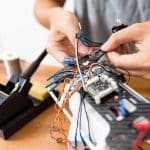As a toy manufacturer, your primary concern should always be the safety of the children who will play with your products. At the same time, you also need to innovate to stay competitive in today’s fast-paced market. Balancing these two requirements is not easy, but with the right approach, you can ensure safety compliance while launching innovative products. It involves understanding the regulatory framework, adhering to product standards, leveraging technology, and engaging with regulators and consumers.
Understanding the Regulatory Framework
Comprehending the regulatory landscape is vital to the safety of your products. In the UK, the toy industry is regulated by the European Union’s Toy Safety Directive (TSD), enforced by the UK government. The directive sets out a comprehensive set of safety and health requirements that all toys sold in the EU must meet.
A voir aussi : What are the essential features of a mobile app for UK community banks to attract young customers?
The TSD covers everything from the design and manufacture of toys to their labeling and packaging. It includes specific restrictions on the use of certain hazardous substances and sets out requirements for warning labels and safety information. It also outlines the obligations of manufacturers, distributors, and importers, and includes provisions for market surveillance by national authorities.
Every UK-based toy manufacturer should be familiar with these regulations. It’s crucial not only to understand what is required under the current directive but also to stay informed about any changes or updates. Regularly reviewing the TSD and other relevant legislation, such as the General Product Safety Regulations and the Consumer Rights Act, will help you keep up to date with the regulatory requirements and ensure that your products are always compliant.
A lire aussi : How can UK local governments enhance public transportation systems with smart technology?
Adhering to Product Standards
Standards are a practical tool for achieving safety compliance. They provide detailed instructions on how to meet the requirements of the TSD and other regulations. The European Committee for Standardization (CEN) has developed a series of harmonized standards for the safety of toys, covering various aspects such as mechanical and physical properties, flammability, and chemical content.
These standards are continually updated to reflect new knowledge and technological advancements. Keeping up with these updates is crucial for innovation. It allows you to incorporate new materials, designs, or technologies into your products while still ensuring safety compliance.
Adherence to these standards also gives you a presumption of conformity with the TSD. It means that if your product meets the relevant standards, regulators will assume that it also complies with the directive’s requirements. It can significantly simplify the compliance process and help you get your innovative products to market faster.
Leveraging Technology
Technology can play a vital role in ensuring safety compliance while promoting innovation. Advanced design tools can allow you to create realistic digital prototypes of your toys and test their safety and performance without the need for physical models. Such tools can also help you identify potential risks and make necessary adjustments early in the design process.
In addition, technologies such as data analytics and artificial intelligence can help you analyze customer feedback, market trends, and regulatory updates. This data can provide valuable insights into potential safety issues, consumer preferences, and emerging trends, helping you to develop innovative products that are both safe and appealing to users.
Engaging with Regulators and Consumers
Finally, open engagement with regulators and consumers can greatly contribute to safety compliance and innovation. Regular consultations with regulators can help you understand their expectations and gain their trust. It can also provide early insights into potential regulatory changes, giving you a head-start in adapting your products.
Similarly, active engagement with consumers can help you understand their needs and concerns. Consumer feedback can provide valuable input for your product development process, helping you to create innovative toys that are not only safe but also meet the expectations of the end-users.
In conclusion, ensuring safety compliance while innovating new products is a challenging but achievable task. By understanding the regulatory framework, adhering to product standards, leveraging technology, and engaging with regulators and consumers, you can create safe, innovative toys that will delight children and satisfy regulators. Remember, safety compliance is not a hindrance to innovation, but a foundation upon which you can build truly successful products.
Embracing the Life Cycle Approach
Understanding the life cycle of a toy can provide valuable insights into ensuring its safety throughout its entire existence. This approach involves evaluating safety at each stage of the toy’s life – from the design and manufacturing process to marketing, use, and eventual disposal. By adopting this method, manufacturers can proactively identify and mitigate potential risks before they occur.
Manufacturers can leverage the life cycle approach to illuminate potential hazards in their products and make informed decisions about materials, design, and production processes. For instance, during the design phase, manufacturers can use advanced simulation tools to predict how a toy will behave under different situations and identify any potential safety issues.
During the production stage, manufacturers can use quality control procedures to ensure that each product meets the required safety standards. They can also use technologies such as artificial intelligence and data analytics to monitor production processes and detect any deviations that could compromise safety.
When it comes to marketing, manufacturers need to provide clear and accurate safety information to consumers. This includes warning labels, instructions for use, and information about the appropriate age group for each toy. Online marketplaces can play a crucial role in disseminating this information and ensuring that it reaches the end-users.
Finally, in the disposal stage, manufacturers need to consider the environmental impact of their products. This includes the use of recyclable materials and the implementation of take-back schemes for used toys. By considering the entire life cycle of a toy, manufacturers can ensure both its safety and its sustainability.
Monitoring and Adapting to the Regulatory Outlook
The regulatory landscape for the toy industry is continually evolving. Manufacturers need to stay abreast of these changes to ensure ongoing compliance and anticipate future developments. This requires a proactive approach to monitoring the regulatory outlook and adapting to new requirements as they emerge.
This is where a comprehensive ‘white paper’ can be of assistance. A white paper is a detailed report that provides a deep dive into a specific topic. In this case, a regulatory white paper can provide a thorough analysis of the current regulations, upcoming changes, and potential future trends in toy safety regulation.
By regularly reviewing such white papers, manufacturers can gain a clear understanding of the regulatory landscape and stay ahead of the curve. They can anticipate changes and start to adjust their practices accordingly, thus ensuring continued compliance and reducing the risk of product liability.
One of the key regulatory developments to watch for is the European Commission’s review of the General Product Safety Directive. This review could result in significant changes to the safety requirements for toys sold in the EU. Manufacturers need to monitor this process closely and be prepared to adapt their products to meet any new requirements.
In conclusion, a proactive, informed approach to safety compliance is crucial for UK toy manufacturers seeking to innovate. By embracing the life cycle approach, staying tuned to the regulatory outlook, and leveraging technology, manufacturers can create innovative, safe, and compliant toys. Remember, at the core of innovation should always be safety. As the firm Osborne Clarke aptly puts it, “Innovation is nothing without product safety”.






